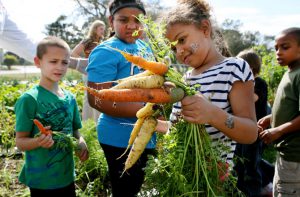If you’ve ever watched a child taste and enjoy a vegetable that she grew herself — the same vegetable that she won’t eat at home that’s from the grocery store — you know some of the power of youth gardening. Children and teens benefit from gardening in many ways, from eating more fruits and vegetables and increased nutrition knowledge to improved leadership and collaboration skills.
 Out-of-school time gardening programs can be connected to school gardens or take place in community gardens and farming spaces. In Ann Arbor Public Schools, our Farm to School Collaborative has been supporting school gardens for many years.
Out-of-school time gardening programs can be connected to school gardens or take place in community gardens and farming spaces. In Ann Arbor Public Schools, our Farm to School Collaborative has been supporting school gardens for many years.
Depending on the garden committee at each school, students are in the garden for lessons during the school day, at recess or lunchtime, and/or for after-school clubs.
Also, each summer, AAPS collaborates with The Farm at St. Joseph, a working farm on a local hospital campus, to offer summer camps for preschool and elementary children. Read more about the camps here. Children and parents love these camps for their hands-on, experiential lessons in gardening, cooking, and nature exploration.
We’re looking at new approaches for deepening middle and high school schoolers’ connection to gardening and food systems in ways that are meaningful to them. How can we use gardening to encourage youth to think of themselves as environmental stewards and change-makers? How can students celebrate their cultural heritage through gardening? In what ways can gardening increase students’ sense of agency in tackling problems in their own community?
One resource is the Slow Food USA’s Ark of Taste Initiative. The Ark of Taste offers a broader context of conservation, biodiversity, food justice, and stewardship for youth to explore. With an ever-growing catalog of “delicious and distinctive food facing extinction,” the Ark of Taste is a tool educators and young people can use to seek out and celebrate our country’s diverse biological, cultural, and culinary heritage. In an out-of-school time setting, students can research, plant, harvest, and introduce their own community to these crops.
We’re also looking at how to apply principles and practice from Place-Based Education (PBE) to our out-of-school time gardening and environmental education opportunities. PBE centers on student-driven inquiry and civic engagement around the history, culture, and environment where students live. Students are empowered to solve real problems where they live. There’s a strong potential connection to agriculture. In my area, the Southeast Michigan Stewardship Coalition has supported PBE with diverse school populations.
What are you doing to create a deeper meaning for youth in your OST gardening, food systems, or conservation work? Share your experiences and resources in the comments.
For breakfast, I had a cup of coffee, an English muffin, and a Clementine.
Author: @jennabacolor